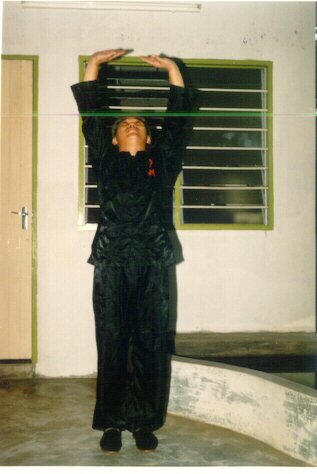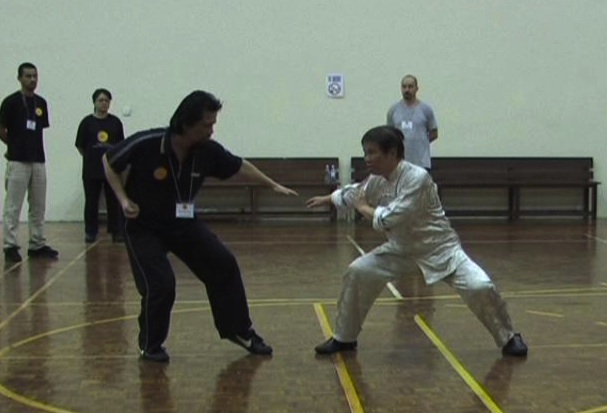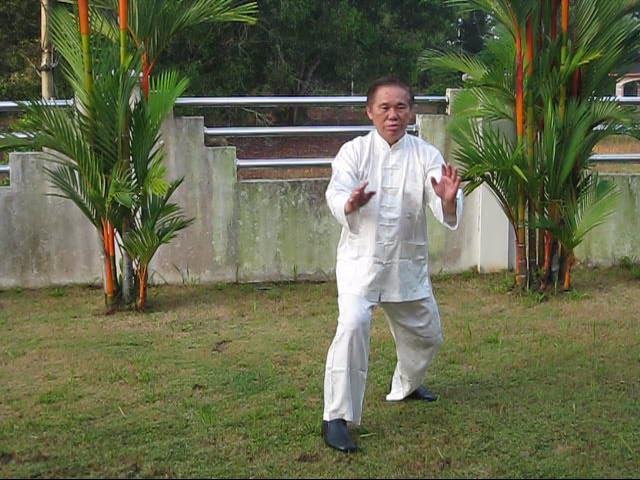SELECTION OF QUESTIONS AND ANSWERS
DECEMBER 2013 PART 3

An old picture showing Grandmaster Wong performing Lifting the Sky, considered a wondrous exercise in our school
Question 1
In my previous chi kung school we were told to train for an hour a day, but you ask us to train for only 15 minutes. Is 15 minutes enough to get good results?
— Matthew, USA
Answer
Different schools need different amount of time for their practice. Most chi kung schools need about an hour, but we need only 15 minutes. And we get more benefits practicing for only 15 minutes than other people get by practicing for an hour.
Many people may think we are boastful, and some may become angry at our statement, but the statement is true. In fact, our concern is to ask our students not to practice for too long a time as it may lead to over-training. For us, 15 minutes of practice is enough to get good results.
Why is it that we need to practice for only 15 minutes to get good results whereas other people have to practice for an hour yet their results are not as good as ours. It is because our chi kung is genuine and powerful, whereas what others practice is low level chi kung or gentle physical exercise.
If it is low-level chi kung, it takes a long time to have some chi kung benefits. If it is gentle physical exercise, it will not produce any chi kung benefits no matter for how long one may practice.
Thus, we practice for only 15 minutes and have more chi kung benefits than others who practice for an hour or more.
Question 2
I have practiced the Eight Pieces of Brocade for more than three years. But just now when I performed Lifting the Sky, which is also found in the Eight Pieces of Brocade, I felt a lot of energy, more than what I had ever felt before. Why is it that I could feel so much energy just now, but could not feel any energy before although I did the same exercise?
Answer
The eight exercises in the Eight Pieces of Brocade are the same as the first eight exercises in our Eighteen Lohan Hands. Lifting the Sky is the first of these exercises.
Although you have practiced Lifting the Sky and other exercises of the Eight Pieces of Brocade for more than three years, you have not felt any energy because you have practiced them as gentle physical exercise. Gentle physical exercise does not generate energy flow.
You felt a lot of energy just now by practicing Lifting the Sky because you practiced it as chi kung, or energy exercise. Chi kung generates energy flow.
Suppose you practice singing. Would you have the result of dancing? No, you won’t. (If you do, it is because you also have practiced dancing, it is not because of your singing practice.)
Similarly, if you practice gentle physical exercise, you would have the result of gentle physical exercise, you won’t have the result of chi kung. You only can have the result of chi kung if you practice chi kung.
A crucial result of practicing chi kung is to generate an energy flow. Just now you could feel a lot of energy because you practiced high-level chi kung. When you practiced the Eight Pieces of Brocade, you did not feel any energy because you practiced them as gentle physical exercise.
Most people can easily differentiate between singing and dancing because the outward forms of singing are different from the outward forms of dancing. But most people cannot differentiate between gentle physical exercise and chi kung because the outward forms of gentle physical exercise are the same as the outward forms of chi kung. Similarly, most people cannot differentiate between Taiji dance and genuine Taijiquan because their outward forms are the same.
You can perform Lifting the Sky as gentle physical exercise or as chi kung. The form is the same. You can also perform Grasping Sparrow’s Tail as Taiji dance or as genuine Taijiquan. The form is also the same.
But the results are different. If you practice Lifting the Sky as gentle physical exercise, you may loosen your muscles and joints. If you perform Lifting the Sky as chi kung, you can generate an energy flow which gives you good health, vitality and longevity.
If you perform Grasping Sparrow’s Tail as Taiji dance, you have a pleasing demonstration. If you perform Grasping Sparrow’s Tail as genuine Taijiquan, you develop internal force and combat efficiency.

Grasping Sparrow's Tail, shown above, can be performed as a dance or an internal martial art
Question 3
It is clear that each sequence builds on the previous ones. But, I also see key motions building on one another as the sequences progress.
— Sifu Gordon, Canada
Answer
The combat sequences are composed with good tactics and strategies in mind. They are built upon the previous ones as well as enable students to develop key combat skills.
When I learned from Sifu Ho Fatt Nam I had to devise my own combat sequences. Now the combat sequences are composed by me based on my rich experience not just to have students save much time but also to enable them to benefit from tactics and strategies.
Question 4
For example, in the basic hand forms “Precious Duck – Single Leg Hand Sweep”, after executing precious duck and when moving back to a false leg stance, the rotation of wrist/forearm in the vertical ready position of the hand in “Single Leg Hand Sweep” is similar to the rotation of the hand/forearm motion of “Bar the Big Boss”, except that it is executed in side horse stance. Or in the “Black Tiger” – “Singe Tiger” hand form, I have found it helpful to practice this pattern by replacing the False Leg Stance with Single Leg Stance or Unicorn.
Answer
Stop intellectualizing and start enjoying your practice.
Practice the pattern as it was crystallized by past masters over many centuries. Modify it on an ad hoc basis when you find it useful.

Dr Damian applies False Leg Hand Sweep against Grandmaster Wong's Precious Duck Swims through Lotus
Question 5
Or another example in Sequence 9 “Happy Bird Hops On Branch”, in response to a side kick, I can see how the defender could possibly deliver a vertical fist to the attacker’s kicking leg. But I can also see how the defender could use the same footwork and downward striking motion of “Strike Drum” to counter other strikes such as “Fierce Tiger”.
It seems the techniques and strategies are sometimes interchangeable. I would like to know if my observations are correct.
Answer
Kungfu is a practical art for practical benefits, which go beyond fighting. Don’t change it into a philosophical subject for intellectualization, and become stressful.
When an opponent executes a side-kick, strike his kicking leg or deliver a vertical punch whichever you find more effective at the moment. You don’t stop and think whether striking drum or vertical punch is more effective, and be kicked while you are still thinking.
In the same way, when you draw some money from an auto-telling machine, you take the money and use it wisely. You don’t pause to ponder whether you should take the money out from the machine with your right hand or your left hand or bite it out with your teeth.
Kungfu is alive. “Lohan Strike Drum” can be used to counter “Happy Bird Hops up Tree”. “Happy Bird Hops up Tree” can also be used to counter “Lohan Strikes Drum”.
Just as expressing love is alive. You can kiss you wife lovingly, and your wife can also kiss you lovingly.
Question 6
If my observations are correct, my next question is when is the correct time to introduce these deeper connections or different possible uses of footwork or techniques such as “Strike Drum” to students in their training? Should I wait until students have completed learning the 16 sequences or is it okay to introduce the students to a deeper understanding of principles and aspects as they go along?
Answer
Your observations are neither correct nor wrong, they are unnecessary.
Teach your students according to our syllabus, guided by their needs and aspirations. Your job as an instructor is to help them acquire skills so that they can be combat efficient as well as to enrich their daily life. Your job is not to burden them with intellectualization so that they become stressful and confused.

Sinking is one of the four cardinal principles in Wuzuquan
Question 7
I have also observed that many Hung Gar practitioners, including masters, often do not align their feet in their Bow-Arrow Stance, and so when they move they do not move from their center or their spine. Nor do they use the swallow/sink or often do not even sink the kidney.
Yet, good Tai Chi and Bagua masters I have observed do use a swallow/sink and move through their stances by moving from their center/spine and they remain centered. In fact many Hung Gar kung fu practitioners kick in very karate-like fashion.
For example, when they execute a roundhouse kick they pivot on the balls of the feet, rather than move through the Unicorn Stance and pivot on the heel of the lead leg to properly position lead foot so they remain grounded as they deliver their kick.
Answer
It is the people rather than the arts that are at fault. If you extend your observation, you may observe Hoong Ka practitioners align their feet in their Bow-Arrow Stance, and Tai Chi and Bagua practitioners not following the swallow-sink principle.
The nature of Hoong Ka Kungfu is such that if performed incorrectly, it looks like Karate, and the nature of Tai Chi Chuan is such that if performed incorrectly, it looks like a dance.
Question 8
It seems that the concept of swallow/sink seems to be an integral aspect of the internal arts. In fact, it seems to make even simple movement like “Lifting the Sky” much more effective. I am just wondering if my observations seem correct.
Answer
You are forcing principles into exercises when they are not needed there. When you perform “Lifting the Sky”, enjoy performing “Lifting the Sky”. Don’t ponder where you should put in the swallow-sink principle. Just like when you eat a steak, enjoy eating the stead. Don’t ponder whether the calories from the stead will go to build your bones or your muscles.
Useful principles are derived from experience, not the other way round. These principles are meant to enhance practical benefits, not for intellectual speculation.
For example, after having performed “Lifting the Sky” for many years and derived many benefits, past masters discovered that if they were standing upright and relaxed, their results would be better. Their repeated experiences crystallized into principles, which were passed on to students for their benefit.
It is not a smart Alex thinking that if he pushes the principle of swallow-sink into “Lifting the Sky”, he would have better result.
LINKS
Selected Reading
- Perception is Often More Important than Reality
- Can We Practice Iron Wire and Wudang Taijiquan at the Same Time?
- The Ultimate Technique
- Themes in Shaolin Combat Sequences and Taijiquan Pushing Hands and Striking Hands
- Looking at Diseases from the Chinese Medical Perspective
